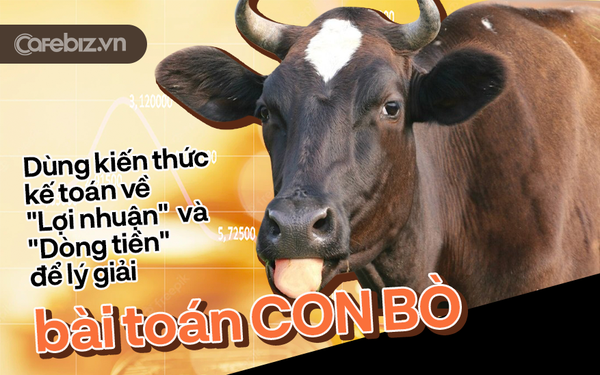The famous online problem of “buying and selling cows” became an accounting exam in an enterprise, beating 50% of the candidates, what is the real solution?
Profit is the difference between a business’s revenue and the costs that the business invests in production to achieve that level of revenue. Profit is considered the final financial result of business activities, production… of the enterprise.
Net cash flow is the amount received after deducting expenses in the business, including: cash flow from production and business activities, cash flow from investing activities, cash flow from operations financial action.

To better understand the difference between the concept of “profit” and “cash flow”, let’s apply it to the controversial story of buying and selling bulls online. This seemingly “beginning” problem was once given as an interview question for an accountant of a certain company.

The cow problem is controversial on social networks
The attraction of this problem probably comes from the controversy between two different answers given by netizens.
Answer 1: The first sale made 2 million, the second time 2 million, a total of 4 million profit.
Answer 2: The initial amount was 10 million, then sold 12 million, 2 million profit. Buying a cow for the second time costs 15 million, the seller has to spend another 3 million (currently has 12 million) equivalent 3 million VND loss. Then sold 17 million, profit 2 million VND. Thus, the total offset 1 million profit.
Which of the 2 answers above is your answer?
Here, we can apply the two concepts “profit” and “cash flow” to clarify the problem.
Profit is the difference between revenue and expenses. Simple in this case is the difference between the buy and sell value. Two times of trading, each time the difference is 2 million dong, which means that the total profit of the cow seller is 4 million dong. This is obvious and quite obvious.
However, why does answer 2 sound reasonable?
Let’s break down the problem of answer 2. The key to the problem is that answer 2 did not correctly determine the working capital turnover, adding the combination of “profit” and “cash flow” into it. in an addition or subtraction calculation. Can you imagine when we add and subtract, we have to use the same frame of reference, like adding the height of a house to the length of a yard in that house, what will it say?
The turnover of working capital, which comes from cash, is converted into inventory (goods), then back to cash (cash-out sales) or through accounts receivable and then back to cash (if sales for debt).
In the bull-seller’s series of transactions, the working capital has rotated 2 rounds of Money – Goods (Cow) – Money, corresponding to 2 trades and generated 2 clearly differentiated profits. The calculation of this time’s revenue with the cost price of the next time is the “reasonably wrong” reason for answer 2.
About “3 million loss” when selling for 12 million and buying back for 15 million sounds reasonable, but it is the product of the ambiguity between “profit” and “cash flow”. Profit, as explained above. And net cash flow is simply understood as the difference between Real Expenses in cash and Real Revenues in cash of a business, if “Revenue” is greater than “Expense” positive cash flow and vice versa.
Specifically: In the case of the cow problem, the cash flow in the period will be calculated as follows:
Spend: 10+15 = 25 million dong
Revenue: 12+17 = 29 million dong
Net cash flow in the period = VND 29 million – VND 25 million, in this case equal to profit because changing factors of working capital such as increase and decrease in inventory, receivables,…
If additional data, for example, the second sale of cows, sold for 17 million VND but the buyer owes 5 million, the net cash flow will change as follows:
Spend: 10+15 = 25 million dong
Collection: 12 + 12 (due to the buyer’s debt of 5 million) = 24 million
Net cash flow for the period = 24 -25 = -1 million dong.
You see, profits didn’t change, but the change in working capital caused cash flow to go from positive to negative. Similarly, the change of other factors in working capital such as inventory,.. or non-cash expenses such as depreciation expense,… will change the cash flow.
With the financial statements of the businessthe cash flow story will be much more complicated, because there are many influencing factors besides the change of working capital such as investment activities, financial activities.
In fact, if you try to find it, there will be almost no business with such primitive activities as the cow seller in the example so that the two indicators of profit and net cash flow for the period are equal.
But understanding the essence of the difference between profit and cash flow, you will understand why so many businesses have positive profit financial statements, but negative net cash flow in the period or vice versa.
If you come across a business in the period with LOTS of main business activities, but during the period the cash flow is POSITIVE, you should not be too surprised. Because it may be because that business receives an additional capital contribution in cash or receives a loan of greater value, or liquidates a fixed asset, a certain capital contribution,….
The writer had time to teach at an accounting training center and received the following situational question: The director (a family company) joined hands to collect and spend money in the period and said the company made a profit of 500 million dong. , while the profit on business results is only 400 million dong. The director requires the accountant to explain the difference, if it cannot be explained, the accountant must make up for the difference 100 million.
In fact, in small and medium-sized companies, especially family-sized businesses, many Directors themselves do not fully understand the accounting profession and financial nature. money on the financial statements, so stories like the above can happen.
If accountants work in a “hands-on” style, without independent thinking and understanding the nature of the problem, when encountering situations like these, it is inevitable to fall into a state of confusion. Just like the cow problem above, when given an interview, the accountant beat up to 50% of the candidates.
at Blogtuan.info – Source: genk.vn – Read the original article here

